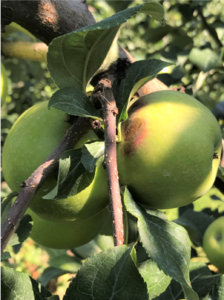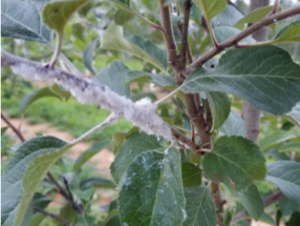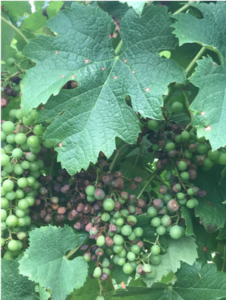Peach:
Oriental Fruit Moth: During the previous week we were between the 2nd and 3rd OFM flights on most farms, and just starting the third flight this week. Populations on most farms are low, but the timing in southern counties is now if trap captures exceed 6 moths per trap. See timings in the table below:
| OFM 3rd Generation Degree Day (DD) Timing | ||||
| Insecticide Type | ||||
| County/Region | Biofix | DD by 7/10 base 45 | Conventional
2100-2200, 2450-2500 |
Diamide
2025-2150, 2375-2450 |
| Gloucester – Southern | 4/8 | 2177
|
1st – 7/9-11
2nd – about 7/19-22 |
1st – 7/7-10
2nd – about 7/16-19 |
| Hunterdon – Northern | 4/16 | 1722 | 1st – about 7/20-24
2nd – too far off |
1st – about 7/17-22
2nd – too far off |
Brown Rot: With the recent rains, sulfur should not be part of the spray program. Most growers should be relying on a captan based program for mid-season covers, followed by better materials during the last 3 weeks pre harvest. See Dr.Lalancette’s recent article in the Plant and Pest advisory for more information.
Scale Insects: Second generation White Peach Scale crawlers should emerge some this week or next. Second generation San Jose Scale crawlers emerge about 7/17 +/- 8 days. Esteem is a good scale material that has a 14 day PHI for stone fruit. Centaur is also effective, has a 14 day PHI and can be used only once during the growing season. The neonicotinoids, Belay and Actara have some efficacy but do not have as long a residual as the other 2 products. Belay has a 21 day PHI, and Actara has a 14 day PHI. Neonicotinoids should not be used unless the orchard groundcover is free of blooming weeds.
Apple:
Rots/Summer Diseases: Once again bitter rot is appearing in highly susceptible varieties such as honeycrisp and empire in southern counties (Figure 1). Mid-Atlantic researchers looking at improving bitter rot control are focusing on bloom and early covers as critical times for control. Because the symptoms do not appear until long after the infection; and pinning down when infections occur can be difficult. Nothing can be done to stop infections which have already occurred but have not yet shown symptoms. Going forward there are several considerations for preventing further infections. If you will be hand thinning, removing infected fruit and either removing them from the orchard or placing them in row middles and chopping them up will help to reduce inoculum present in the canopy. Where dead shoots are present from fire blight or any other cause, prune them out to reduce inoculum buildup. Maintain good coverage with captan at high rates. The addition of a phosphite material to captan may improve control of all summer diseases. Avoid potassium phosphite materials on Honeycrisp as potassium may contribute to bitter pit problems. Merivon (FRAC 7+11) with a 0 day PHI for pome fruit, has been shown to have good efficacy against all summer diseases including bitter rot. Luna Sensation (FRAC 7+11) is also labeled for bitter rot control, and has a 14 day PHI for pome fruits. Combination materials that contain Qol inhibitors (the “strobin” materials, including Merivon and Luna Sensation), are also effective for white and black rot. Researchers in Pennsylvania are reporting that the fungicide Omega (FRAC 29) (fluazinam) looks good in lab trials for bitter rot, and that Topsin-M (FRAC 1) may have some efficacy. However, this material was not effective in research trials in NY. Be aware that Omega has a 28 day PHI and may be weak for white rot. Therefore possible programs include for the second half of the season: Captan plus Merivon or Luna Sensation, or Captan alone at the high rate, or Captan + Omega (if greater than 28 days PHI).

Figure 1. Early symptoms of bitter rot on Honeycrisp. (Photo – D. Schmitt)
Codling Moth (CM): The timings are updated below for second generation CM. Trap counts and emergence are still very low, but should increase over the next week.
| Codling Moth Degree Day Timing – Model Predictions | ||||||||
| Application and Insecticide Type | ||||||||
| County Area | Biofix | Rimon:
1150-1200 DD + 14-17 days later, or 1450-1500 DD
|
Intrepid and
Diamides – Altacor, Exirel, Voliam mixes: 1200-1250 DD + 1550-1600 (14-21 days later) |
Cyd-X, Madex, Carpovirusine
1250 DD + every 7-9 days during brood hatch (later if first spray is an IGR) |
Standard Insecticides – Delegate, Avaunt, OP’s, carbamates, pyrethroids
1250-1300 DD + 1600-1650 DD
|
|||
| DD | 1150 | 1200 | 1250 | 1550 | 1250 | 1250 | 1600 | |
| Southern | April 25 | past | past | past | 7/14-7/16 | past | past | 7/15 |
| Northern | May 1 | 7/8 | 7/10 | 7/12 | 7/18-7/20 | 7/15 | 7/15-7/18 | 7/20-21 |
Woolly Apple Aphids (WAA): Additional farms, heavier colonies (Figure 2) and an increased number of colonies per tree are being seen in northern counties. This insect has at least 3 generations per year, and we are likely headed into the 3rd generation at the present time. Heavy populations (Figure 2) will remain on the tree through harvest and can damage the fruit. Heavy populations can also lead to colonies going into the soil stage and feeding on the roots. Root feeding can lead to short fibrous roots, which can be particularly damaging on young trees. Several weeks ago a planting was seen that came from a nursery, already infested with WAA on the roots. The root system was small and trees easily pulled out of the ground 2 months after planting. Fortunately the insect can be heavily parasitized. However if populations are increasing, then treatments may be advised. Closer, Diazinon and Movento are the best materials. However, as leaves thicken and get tougher to penetrate, the use of Movento becomes marginal. Diazinon can only be used once, so you have to carefully choose their target for which to use it against. Closer is a systemic material and can be used up to 4 times per season, but not at more than a total of 17 fl. oz./A. Use the high rate of 5.75fl. oz./A for WAA control. Avoid contact with flowering weeds or other flowering plants.

Figure 2. Large WAA colony on apple during early July. (Photo – A. Atanassov)
Scale Insects: Second generation San Jose Scale should emerge about mid-July. We have not seen crawlers as of this date. Options include Esteem (2 applications/year; 45 day PHI); Centaur (1 application/year; 14 day PHI); Diazinon 50W (2 applications/year; 21 day PHI).
Grapes:
Disease Management: Downy Mildew control typically drives the summer fungicide program however some disease symptoms may appear long after the infection has occurred. Black rot symptoms in clusters began appearing in southern counties this week (Figure 3) where leaf infections were noted several weeks ago. Since the symptoms don’t appear on berries until they are pea sized, these infections likely occurred at the same time as the leaf infections but are just now expressing themselves. Fruit remain susceptible to infection for up to 6 weeks after bloom for vinifera varieties and up to 5 weeks for natives so you still may need to cover for black rot protection.

Figure 3. Black rot symptoms on leaves and berry clusters. (Photo – D. Schmitt)
Grape Berry Moth (GRB): for the 2nd generation, or the first generation that is important in cultivated grapes are over. Treatments for the third generation should be approximately in the middle of the month, or at an accumulation of 1620 degree days (base 47.14) since the biofix of May 13 in the Bridgeton area. This will be on or around 7/14 in southern counties.
Grape Trap Counts
| WEEK END | GBM | GRB |
| 6/1/2019 | 0 | |
| 6/8/2019 | 9 | |
| 6/15/2019 | 6 | 0 |
| 6/22/2019 | 2 | 1 |
| 6/29/2019 | 3 | 0 |
| 7/6/2019 | 7 | 2 |
Tree Fruit Trap Counts – Southern Counties
| Weekending | STLM | TABM-A | CM | AM | OFM-A | DWB | OFM-P | TABM-P | LPTB | PTB |
| 4/27 | 8 | 1 | 3 | 110 | 29 | 0 | ||||
| 5/4 | 4 | 5 | 6 | 34 | 17 | 1 | 0 | |||
| 5/11 | 2 | 8 | 5 | 31 | 5 | 5 | 0 | |||
| 5/18 | 2 | 32 | 8 | 21 | 23 | 2 | 11 | 34 | ||
| 5/25 | 2 | 34 | 7 | 0 | 39 | 0 | 32 | 34 | ||
| 6/1 | 1 | 51 | 11 | 1 | 71 | 1 | 56 | 47 | ||
| 6/8 | 13 | 25 | 6 | 14 | 2 | 26 | 56 | |||
| 6/15 | 20 | 8 | 3 | 51 | 83 | 3 | 11 | 33 | ||
| 6/22 | 35 | 4 | 1 | 9 | 79 | 5 | 3 | 13 | 0 | |
| 6/29 | 33 | 0 | 0 | 7 | 3 | 0 | 18 | 4 | ||
| 7/6 | 24 | 2 | 1 | 2 | 97 | 3 | 1 | 19 | 2 |
Tree Fruit Trap Counts – Northern Counties
| Weekending | STLM | TABM-A | CM | AM | OFM-A | DWB | OBLR | OFM-P | TABM-P | LPTB | PTB | |
| 4/6 | 0.3 | |||||||||||
| 4/13 | 2 | |||||||||||
| 4/20 | 10 | 0 | 0.2 | 0.9 | ||||||||
| 4/27 | 9 | 0 | 0 | 4 | 9.5 | 0 | ||||||
| 5/4 | 9 | 0.1 | 0.2 | 7 | 0 | 0 | 17.1 | 0.2 | 0 | |||
| 5/11 | 10 | 0.6 | 1.2 | 4 | 0 | 0 | 5.8 | 2 | 2.5 | 0 | ||
| 5/18 | 6 | 2.7 | 0.8 | 5 | 0 | 0 | 5.6 | 5.2 | 1.4 | 0 | ||
| 5/25 | 3 | 13.3 | 2.9 | 3 | 2 | 0 | 1.1 | 10.8 | 4.5 | 0 | ||
| 6/1 | 5 | 22.4 | 3.2 | 4 | 4 | 0.5 | 3.1 | 14.7 | 5.7 | 0 | ||
| 6/8 | 8 | 40.4 | 3.8 | 1 | 1.3 | 2 | 1.7 | 32.5 | 8.3 | 0.3 | ||
| 6/15 | 27 | 44 | 3 | 2 | 2 | 17 | 2 | 52 | 2.4 | 1.3 | ||
| 6/22 | 15 | 27.6 | 0.8 | 1 | 0.5 | 2.5 | 3.6 | 28.6 | 0.3 | 1.5 | ||
| 6/29 | 133 | 12.8 | 1.8 | 3 | 2.8 | 0 | 3.3 | 10.6 | 3.7 | 0.7 | ||
| 7/6 | 88 |
|
1.2 | 4.8 | 2.4 | 4.5 | 4.4 | 7.1 | 3.1 | 0.3 |
Blueberry:
Spotted Wing Drosophila (SWD): Trap counts indicate increasing population pressure. While trap captures are only relative, and there is no treatment threshold, trap counts have increased a minimum of 16x since the previous week. All plantings should continue to have protection. When treating Bluecrop, Elliott and other late fields, make sure to stay on a tight schedule. Machine picked Duke fields will have dropped fruit in which SWD will continue to breed. While we do not recommend spraying these fields; if those fields border a field that is not yet picked, it doesn’t hurt to include those edge rows with the covers used on still producing fields. At this time of year, many growers are using pyrethroid programs
We had a question this week on the longevity of Danitol when used for SWD control. Like most pyrethroids, Danitol can be short lived, especially in sunny and hot weather. In this case, research data has shown that the active ingredient in Danitol, fenpropathrin can break down quickly. Data gleaned from the U.S. National Library of Medicine, TOXNET: “Particulate-phase fenpropathrin will be removed from the atmosphere by wet and dry deposition. Fenpropathrin is also rapidly degraded by direct photolysis in the atmosphere and should not persist for more than a few days.” Therefore remember that your spray programs should not be stretched, even though you might see the “light at the end of the tunnel.”
Blueberry Maggot (BBM): Adults continue to be captured at very low levels, and are “0” on most traps. Remember that the blueberry maggot is a regulated pest if you are still exporting to Canada, and that the tolerance for fruit with larvae is still “0”.
Scale: Scale is not an issue, and we are still between the 1st and 2nd generations of Putnam Scale. For those growers with scale infested bushes, it’s a good idea to wait until the second generation of crawlers are present in another few weeks.
Aphids: Aphid infestations have decreased since last week, and should not be a problem for most growers. Isolated plantings still show up to 5-10 aphids per shoot, but the average percent terminal infestation is low.
Anthracnose and Alternaria: Anthracnose field symptoms are present on Bluecrop. Some Alternaria is also present at levels that average .06% of scouted fruit.
Blueberry Traps
Atlantic County Traps
| Week Ending | SWD | OB | BBM | SNLH |
| 6/8 | 1.05 | 8.2 | 0 | == |
| 6/15 | 1.2 | 97 | 0 | == |
| 6/22 | 0.71 | 1381 | 0.21 | 0.21 |
| 6/29 | 4 | 2385 | 0.03 | 0.11 |
| 7/6 | 64 | 1856 | 0.06 | 0.15 |
Burlington County Traps
| Week Ending | SWD | OB | BBM | SNLH |
| 6/8 | 0.07 | 2.91 | 0 | == |
| 6/15 | 0.83 | 69 | 0 | == |
| 6/22 | 0.7 | 750 | 0.33 | 0.33 |
| 6/29 | 0.64 | 1113 | 0.125 | 0.8 |
| 7/6 | 100 | 2048 | 0.2 | 0.625 |

